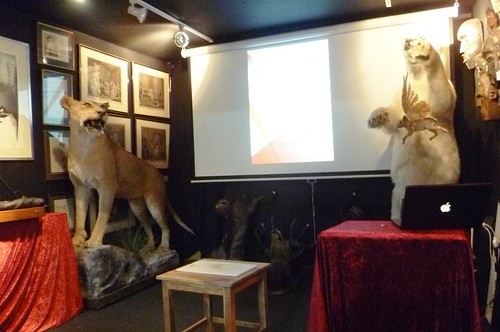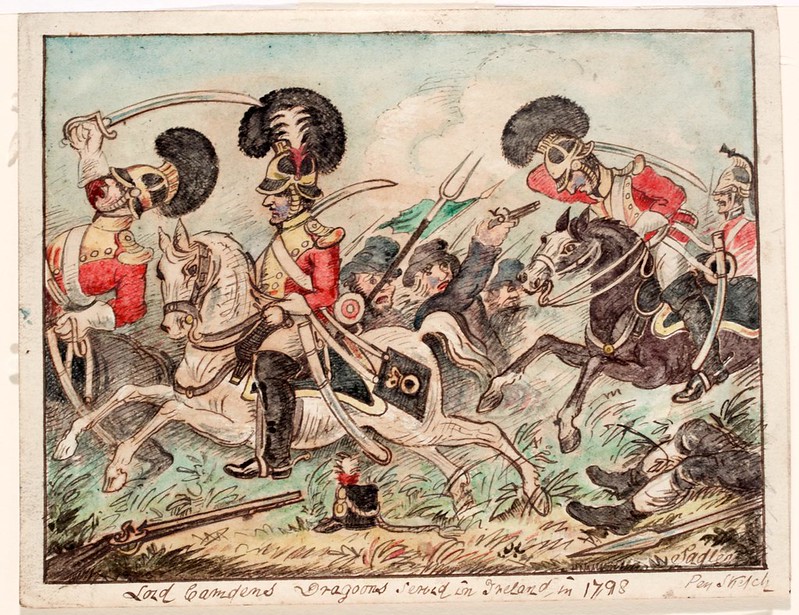 |
| "Last Tuesday" lecture... http://www.flickr.com/photos/davidsankey/9151602532/ |
I went to a lecture by Mike Jay on James Tilly Matthews and the influencing machine http://mikejay.net/books/the-influencing-machine-2/ -- which remnded me of signal stations I saw in Ireland......
James Tilly Matthews is considered by some to be the earliest documented example of paranoid schizophrenia. He was committed to Bethlem (Bedlam) hospital in London, against his will, in 1797 believing himself to be controlled by the "Air Loom gang" who operated a machine in a basement in Moorgate, using the stinking effluvia of the district to control his thoughts. Earlier h had traveled to revolutionary France to prevent the onset of war between Britain and the Girondist government. His association with Girondists led to his arrest when they were overthrown by their Jacobin successors. Thrown in jail by Jacobins, he was released when they considered him mad. returning to the UK he was committed to an asylum after being arrested for shouting "Treason" in parliament. His case documented by Apothecary John Haslam (who drew the above illustration). Matthew's relatives considered him sane and tried top get him released under a writ of Habeus Corpus. there is some evidence of political influence on Bedlem and Haslam argued he was a danger to authorities and the public.Whilst being documented by Haslam - Matthews kept notes on him - which formed evidence to a parliamentary Select Committee on conditions in Bedlam, leading to the dismissal of Haslam! --- The key importance of Matthews is that prior to this time, intrusive thoughts were more likely to be ascribed to spirits, demonic possession, or the voice of angels (think St Joan). But Matthews lived at the birth of scientific modernity, machines, gasses, and remote communications were the zeitgeist.
How mad was he? Revolutionary wars led to the elevation of Napoleon Bonapart and his reactionary nemesis - Alnglo-Irish - Wellington... Fear of invasion aiding the rebellion of nationalist Irish led to a chain of signalling stations, around the Irish coast and through England. Remote communications became a reality, as did competing "kite-ed" ideas of democracy and authority. The physical legacy is a chain of towers in visual communication over vast distances, which link the two nations subsequently divided. Sometimes, it is the difficulty of reconciling competing thoughts and interests in a single mind that leads to an outburst of metaphorical conception. The line between savant, seer, artist and lunatic is exceedingly thin, -the idea of madness being an attack of "unreason" as opposed to demonic possession, or divine inspiration, arose during the Age of Reason, when Asylums were invented (according to Foucault) . As Matthews example shows, madness is not an irrational construct, but an attempt to rationalise invasive thoughts and sensations, hallucinations, etc. The Air Loom conformed to cutting-edge scientific rationality - as best he could understand it. Whilst Matthews may well have been mad - he was nowhere near as insane as the warring states and their attempts to impose ideologies.
 |
| Air Loom influencing machine gang using fluids and humours (gasses) to control James Tilly Matthew http://www.theairloom.org/about.html |
James Tilly Matthews is considered by some to be the earliest documented example of paranoid schizophrenia. He was committed to Bethlem (Bedlam) hospital in London, against his will, in 1797 believing himself to be controlled by the "Air Loom gang" who operated a machine in a basement in Moorgate, using the stinking effluvia of the district to control his thoughts. Earlier h had traveled to revolutionary France to prevent the onset of war between Britain and the Girondist government. His association with Girondists led to his arrest when they were overthrown by their Jacobin successors. Thrown in jail by Jacobins, he was released when they considered him mad. returning to the UK he was committed to an asylum after being arrested for shouting "Treason" in parliament. His case documented by Apothecary John Haslam (who drew the above illustration). Matthew's relatives considered him sane and tried top get him released under a writ of Habeus Corpus. there is some evidence of political influence on Bedlem and Haslam argued he was a danger to authorities and the public.Whilst being documented by Haslam - Matthews kept notes on him - which formed evidence to a parliamentary Select Committee on conditions in Bedlam, leading to the dismissal of Haslam! --- The key importance of Matthews is that prior to this time, intrusive thoughts were more likely to be ascribed to spirits, demonic possession, or the voice of angels (think St Joan). But Matthews lived at the birth of scientific modernity, machines, gasses, and remote communications were the zeitgeist.
How mad was he? Revolutionary wars led to the elevation of Napoleon Bonapart and his reactionary nemesis - Alnglo-Irish - Wellington... Fear of invasion aiding the rebellion of nationalist Irish led to a chain of signalling stations, around the Irish coast and through England. Remote communications became a reality, as did competing "kite-ed" ideas of democracy and authority. The physical legacy is a chain of towers in visual communication over vast distances, which link the two nations subsequently divided. Sometimes, it is the difficulty of reconciling competing thoughts and interests in a single mind that leads to an outburst of metaphorical conception. The line between savant, seer, artist and lunatic is exceedingly thin, -the idea of madness being an attack of "unreason" as opposed to demonic possession, or divine inspiration, arose during the Age of Reason, when Asylums were invented (according to Foucault) . As Matthews example shows, madness is not an irrational construct, but an attempt to rationalise invasive thoughts and sensations, hallucinations, etc. The Air Loom conformed to cutting-edge scientific rationality - as best he could understand it. Whilst Matthews may well have been mad - he was nowhere near as insane as the warring states and their attempts to impose ideologies.
 |
| Admiralty in 1790 -- the centre of the UK semaphore Telegraph in 1790s (from http://upload.wikimedia.org/wikipedia/commons/c/c4/Admiralty_building_Whitehall_1790_.jpg |
 |
| Chatley Heath Semaphore station |
 |
| Ireland's 81 signal stations http://www.irishtimes.com/news/environment/ireland-s-napoleonic-era-signal-towers-1.1253929 |
 |
| Just visible - Napoleonic signal station on Mutton Island, Co Clare, Ireland http://www.panoramio.com/photo/27162274 |
Ireland's signal stations were completed in 1806 -- 8 years after the 1798 rebellion.... (Matthews was committed in 1797)
 |
| Lord Camden's Dragoons 1798 9From the National Library of Ireland |
 |
| Development of Franch telegraph http://www.bbc.co.uk/news/magazine-22909590 |
This comment has been removed by a blog administrator.
ReplyDelete